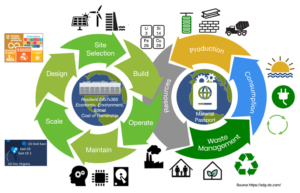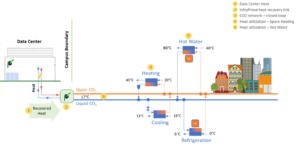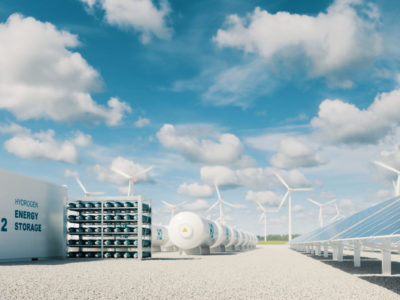Sustainability Innovation for a Carbon Free Future
Sustainability Innovation for a Carbon Free Future
Sustainability Computing: Zero Carbon Haven at AQ Compute
Authored by Susanna Kass, Energy Fellow, Stanford University, UN SDG-EP with contributions by Jaime Comella, Lead Data Centre Architect, AQ Compute
Renewable Energy and Energy Storage are going through a breakthrough transformation in its own economics to show its promise to scale in new opportunities to power the Net Zero Data Centers with affordable, clean energy. It is proven that the hyperscalers in the past two decades; AWS, Microsoft Azure, Google GCP, Meta-Facebook, Apple are responding with Gigawatts of Renewable Energy purchases, its fence-thinking strategies to meet its Carbon Neutrality Goals.
- Figure 1: Renewable Energy (Shutterstock, Blue Planet Studio)
- Figure 2: Energy Storage (AdobeStock, malp)
AQ Compute focus is to accelerate the growth trend to enable Carbon Neutral Data Centers throughout the Data Center Lifecycle, by introducing Zero Carbon Haven across a pan-European site portfolio to accelerate carbon free communities in European Union countries.
Data centre at the core of a renewable energy and circular ecosystem

Figure 4: Circular Economy for Data Center Lifecycle Source: Susanna Kass https://sdg-dc.com
AQ Compute and its parent company, Aquila Capital, collectively are advancing more sustainable computing across an existing and future pan-European fleet of site(s) with eco-conscious, cloud-sovereign data centers, ensuring end-to-end optimal path networks, and circularity, reducing the depletion of environmental resources. Specifically, AQ Compute aims to offer a Zero Carbon Haven Computing, specifically for higher density GPU- computing and AI-driven software supporting a 24/7 renewable energy platform.

Figure 5: Clean energy infrastructure to harmonize with carbon free community (Source: Shutterstock, liyuhan)
In an industry driven by electrical power, AQ Compute is conscious of the importance of ensuring a renewable energy supply to power its data centers. The parent company, Aquila Capital has a track record in developing Gigawatt scale renewable energy projects, utility scale energy storage as an asset management company. This approach accelerates Data Center operators to get access to zero carbon emissions power supply. Net Zero Data Center gains carbon free energy of on premise renewable energy assets at AQ Compute, a Zero Carbon Haven compute platform with net positive impacts. Additionally, with Power Purchase Agreements (PPAs) for the Data Centers can accelerate to meet the Carbon Neutrality goals. AQ Compute, via Aquila Capital, stated its commitment to match per megawatt of renewable power needed by AQ Compute Data Center clients with new and incremental renewable power project development. The result is more clean energy for our people, our planet and scale for growth with profits in a carbon free future.
AQ Compute’s data centres aim to act as power grid stabilizer using its on premise energy platform and back-up systems. In times where renewable energies are massively entering into the power grid mix, frequency stabilizing mechanisms are required. Hyperscale data centers having intensive loads, are candidates that can operate continuously without connecting to the grid hence achieving resiliency with the highest uptime performance.
Each data centre has excess heat, and millions are spent in cooling technologies. The excess heat resource can be reused in the circular data centre ecosystem to provide new value to society of cost saving benefits of heating services. Sustainable Innovation includes high temperature direct liquid cooling from the ITE and CO2 as a thermal carrier to carry the excess heat from the data centre that is extracted directly from air or liquid cooling. The circular network of excess heat prototypes are working now in megawatt scale and can be ignitors in Gigawatt scale. The results are impactful to the environment; reduce hundreds of millions of GHG emissions to the environment; economic savings of not needed power to cool the data centres and reduced energy cost savings for society to receive heating from the excess heat from data centres in a circular ecosystem.

Figure 6: Heat Reuse from Data Centers (Susanna Kass)
It is an opportune time to invert the status quo of a linear economy. Net Zero data centre is a new generation to revitalize a clean energy and circular ecosystem creating new value to the communities and to the environment, by:
- Improving renewable power access of the society with additional renewable energy project developments to green the grid, triggered by the development of data centres
- Increasing resiliency of local grid with data centre technologies
- Reducing energy costs and emissions of heating for surrounding residents and businesses through access of excess heat from data centre
Sustainability Innovation
- Provides the blueprint to assess and plan for a holistic approach of Sustainable Computing which consists of high-density GPU, AI-enabled compute capacity to unleash the scale of transformative productivity gains to its full economic potential.
- Defines the pillars with a new lens towards Net Zero design for Net Positive Impacts:
- resilience (anticipate, adapt, resolve, resume) normal operation measured by zero downtime
- impact (reduce and eliminate emissions of responsible consumption and generation of energy)
- effectiveness (performance, sovereignty, security)
State-Of-the-Art computing needs also to be sustainable in its consumption of resources. AQ Compute tracks the computational capabilities trends required for modern Machine Learning systems which is measured in floating-point operations per second (FLOPS). The fact shows it has grown by hundreds of thousands of times since 2012. (OpenAI, 2018[1]; Sevilla et al., 2022[2]), despite algorithmic and software improvements that reduce computing power.
Deep learning dramatically increased the size of machine learning systems, and their compute demands. There is a shift in the industry from general-purpose processors, namely Central Processing Units (CPUs), to processors that include specialized hardware and support more efficient compute execution for certain operations (i.e., requiring less energy and achieving more computations per unit of time). Today, Machine Learning systems are predominantly trained on specialized processors that comprise hardware optimized for certain types of operations, such as Graphics Processing Units (GPUs), Tensor Processing Units (TPUs), Neural Processing Units (NPUs), and others. It is less efficient for AI systems, Security systems, Data Science Systems, Quantum Networks that correlate massive data to use traditional CPUs.
Aligning Sustainable Compute Capacity with Sovereign Cloud Strategies
To address a gap in the industry, AQ Compute Sustainability Leadership works in UN SDG-EP and is one of the Climate Experts, Researchers at The Intergovernmental Panel on Climate Change (IPCC) Group to help policy makers align sustainability policy with national clean energy standards. These considerations are not exhaustive and vary according to national contexts and needs, they are the outcome of extensive evidence-based framework by the Expert Group members and exemplify a science-based approach on how to systematically measure and plan Sustainable Computing capacity for current and future Digital Transformation Business needs. The government head of EU countries should consider AQ Compute platform to future proof its national investments relative to meeting its national policy objectives, including public-sector budget, national allocations and private-sector investments. Policy makers ought to use evidence-based models to shape the most resilient approach by the country’s context and needs. Such an approach is strategic to include the use of its investments and sponsored strategic partnerships with AQ Compute Sustainability Leadership to gain sovereignty amongst cloud providers. Policy makers can consider how public- and private-sector investments in a country Sustainable computing capacity can advance different types of policy objectives for its countries. Scaling out AI- enabled Sustainability Computing can future proof investments. AQ Compute pan-European sites enable agility and growth, at EU-scale. The scaling out approach is proven and commonly seen in countries where multiple smaller clouds are installed and replicated in availability zone(s) for resilience support to broaden access with efficiency.
Looking Beyond: Invert Status Quo To Take Action to Make Net Positive Impact

Source: UN SDG, Susanna Kass
“In my journey, I have fought for what I believe in and what the UN SDG Environmental Program and Stanford University stand for. The impact of a carbon free future is paramount for our generation. We must take action to pave the way for the future generations of people. The planet itself is resilient; meanwhile, humans are depleting our natural ecosystems at a fast pace in a linear economy; grab, use, toss.” said Susanna Kass. I lead in a way to make each moment count, which is actually the motto of Stanford University Graduate School of Business (GSB). Recently, Susanna became a member of the Stanford University GMB board Women’s Circle Growth and Ops, leading impact and analysis. Back to the Data Centers, however, I would like to take action with Data Center cloud providers as a clean cloud builder and start each day as the first working relentlessly to make a net positive impact with Net Zero providers. AQ Compute Zero Carbon Haven Sustainability Computing platform exemplifies the SDG impact.” I would like to help lead the next 30 Gigawatt of Renewable Energy Data Center projects by 2030.”
Back to Blog










